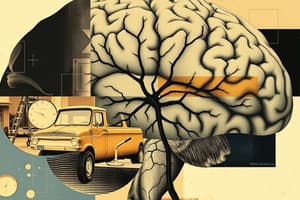Podcast
Questions and Answers
What is the main function of the central nervous system (CNS)?
What is the main function of the central nervous system (CNS)?
- Regulating hormones and body temperature (correct)
- Processing food digestion
- Controlling only movement
- Aiding in cell reproduction
Which part of the brain is responsible for sensory processing and motor control?
Which part of the brain is responsible for sensory processing and motor control?
- Frontal lobe
- Temporal lobe
- Occipital lobe
- Parietal lobe (correct)
What are the three protective membranes covering the brain called?
What are the three protective membranes covering the brain called?
- Dura mater, arachnoid mater, pia mater (correct)
- Frontal protector, rear shell, lower casing
- Inner shield, outer guard, top cover
- Brain skin, skull coating, memory shield
Which lobe of the brain is mainly responsible for emotional regulation?
Which lobe of the brain is mainly responsible for emotional regulation?
What are neurons responsible for in the central nervous system?
What are neurons responsible for in the central nervous system?
Why is the brainstem considered crucial for vital functions?
Why is the brainstem considered crucial for vital functions?
What is the primary function of the medulla oblongata in the brain?
What is the primary function of the medulla oblongata in the brain?
Which part of a neuron carries impulses away from the cell body?
Which part of a neuron carries impulses away from the cell body?
What is the main role of glial cells in the brain?
What is the main role of glial cells in the brain?
How do neurons communicate with each other?
How do neurons communicate with each other?
Which type of neuron receives signals from the brain and initiates muscle contractions?
Which type of neuron receives signals from the brain and initiates muscle contractions?
What happens when neurotransmitters bind to receptors on a postsynaptic cell?
What happens when neurotransmitters bind to receptors on a postsynaptic cell?
Study Notes
Understanding the Central Nervous System: Brain and Neurons
Introduction
The central nervous system (CNS) is a crucial part of the human body, responsible for controlling a wide range of functions, including thought, movement, and emotion, as well as respiration, heart rate, hormones, and body temperature. Consisting mainly of the brain and spinal cord, the CNS functions as the command center for the body, integrating and processing information from sensory organs and sending instructions to muscles and various organs through the peripheral nervous system (PNS). This article delves into the structure and function of the CNS, focusing on the brain, neurons, and their roles within this vital organ system.
The Brain
The brain is the most complex organ in the body, accounting for approximately 2% of an individual's total body weight. It is housed within the skull and protected by three membranes called the meninges (dura mater, arachnoid mater, and pia mater). The brain can be divided into four main lobes: the temporal lobe, parietal lobe, occipital lobe, and frontal lobe. Each lobe has a specific function related to sensory processing, motor control, cognitive function, and emotional regulation.
Structure and Function of the Brainstem
The brainstem is crucial for vital functions such as breathing, heart rate, blood pressure, and vomiting. It contains several structures, including the medulla oblongata, which regulates these functions, and the hypothalamus, responsible for controlling body temperature, thirst, hunger, and hormone secretion.
Neurons
Neurons are specialized cells that transmit information throughout the nervous system via electrical signals known as action potentials. They consist of a cell body, axon, and dendrites. Axons serve as extensions that carry impulses away from the cell body to other neurons or muscle fibers, while dendrites receive impulses from other neurons.
Types of Neurons
There are two primary types of neurons: sensory neurons and motor neurons. Sensory neurons detect stimuli from external sources, like touch or temperature, and send this information to the spinal cord or brain. Motor neurons, on the other hand, receive signals from the brain and initiate muscle contractions, leading to movement.
Glial Cells
Glial cells, often referred to as neuroglia, support neurons and maintain overall brain function. They perform various roles, such as forming insulating layers around axons (oligodendrocytes in the central nervous system and Schwann cells in the PNS), regulating blood flow, providing nutrients to neurons, disposing of waste products, and maintaining the structure of the brain.
Neurotransmitters and Synapses
Neurons communicate with each other through specialized junctions called synapses. When an action potential reaches the end of an axon, it triggers the release of chemical messengers known as neurotransmitters into the synaptic cleft. These molecules then bind to receptors on the postsynaptic cell, either another neuron or a target muscle fiber, causing an electrical or biochemical response.
Conclusion
Understanding the intricate workings of the CNS, specifically the brain and neurons, provides valuable insight into the complex processes that underlie our thoughts, movements, emotions, and other essential functions. While much remains to be discovered about this fascinating organ system, ongoing research continues to shed light on its structure and function, leading to new treatments and therapies for various neurological disorders.
Studying That Suits You
Use AI to generate personalized quizzes and flashcards to suit your learning preferences.
Description
Test your knowledge on the central nervous system (CNS) by focusing on the brain, neurons, and glial cells. Explore the structure and functions of the brain, types of neurons, and the roles of glial cells in maintaining overall brain function. This quiz will cover topics such as brain lobes, neurotransmitters, synapses, and the vital functions controlled by the CNS.




